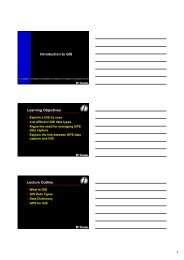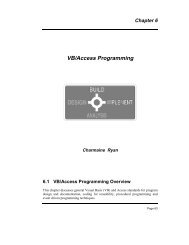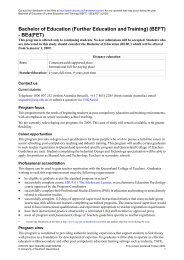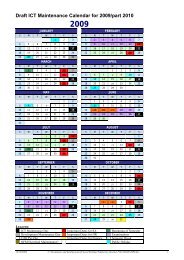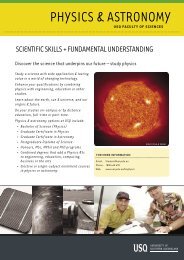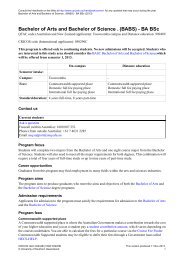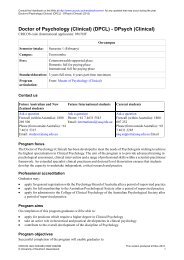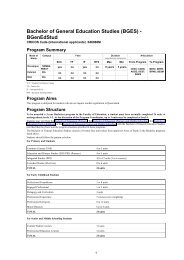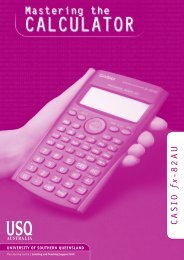a description of the biographical characteristics of process
a description of the biographical characteristics of process
a description of the biographical characteristics of process
You also want an ePaper? Increase the reach of your titles
YUMPU automatically turns print PDFs into web optimized ePapers that Google loves.
Journal <strong>of</strong> Management Practice Volume 3, No. 2 2000aspects <strong>of</strong> <strong>the</strong>ir role during <strong>the</strong> previous calendar year. During <strong>the</strong> same year at least one WPRmust be conducted with each staff member. The purpose <strong>of</strong> this review is to discuss <strong>the</strong>employee’s performance and that <strong>of</strong> his or her leader. Currently, WPA scores range in valuefrom 0–100, where 30 is considered a performance level that meets <strong>the</strong> minimumrequirements <strong>of</strong> <strong>the</strong> role. A score above 85 indicates a performance that continually exceeds<strong>the</strong> full requirements <strong>of</strong> <strong>the</strong> role. A new rate <strong>of</strong> salary commences in April each yearcalculated from <strong>the</strong> performance score. A score above 65 is considered indicative <strong>of</strong> a highperformingemployee. It <strong>the</strong>n follows that <strong>the</strong> company is likely to be interested in retaining<strong>the</strong>se staff.LITERATURE REVIEWDuring <strong>the</strong> research <strong>process</strong>, <strong>the</strong>oretical principles drawn from human resource management,organisational behaviour and management and <strong>the</strong> social sciences were applied as necessaryto <strong>the</strong> issues. In addition, any literature in research journals that addressed <strong>the</strong> issue <strong>of</strong>employee turnover and <strong>biographical</strong> data was examined.DefinitionOne influential review <strong>of</strong> <strong>the</strong> topic proposed that a universally accepted definition <strong>of</strong> biodatacannot be found. In this review, biodata is described essentially as information about <strong>the</strong>personal life-history and experience that an individual provides through resumes, interviews,and applications for employment. When applied to <strong>the</strong> selection <strong>process</strong> <strong>the</strong>y are presumed tobe related to success in occupational endeavours and are predictors <strong>of</strong> certain work-relatedbehaviours (Gunter, Furnham & Blakeley 1993).The literature refers to ‘hard’ and ‘s<strong>of</strong>t’ biodata. The former relates to <strong>the</strong> more factualdemographic and background information found on most application blanks and is historicaland verifiable (Nickels 1990). The latter refers to more abstract and subjective data whichinclude items <strong>of</strong> a more private nature such as judgments, motivations and expectations(Gunter et al. 1993). Many argue that only <strong>the</strong> individual’s verifiable life-history events andexperiences from work and private life should be considered as legitimate biodata. Thiscontention supports <strong>the</strong> information found on application blanks, ra<strong>the</strong>r than on an extensive<strong>biographical</strong> questionnaire that tend to focus more on <strong>the</strong> ‘s<strong>of</strong>t’ data (Gunter et al. 1993). It is<strong>the</strong> ‘hard’ data that are more applicable in this study because <strong>of</strong> <strong>the</strong> nature <strong>of</strong> <strong>the</strong> informationsought by <strong>the</strong> client and <strong>the</strong> introductory nature <strong>of</strong> <strong>the</strong> research.HistoryThe concept <strong>of</strong> <strong>biographical</strong> data (biodata) has a long history and <strong>the</strong>se data have been used asselection tools for most <strong>of</strong> this century. However, it has only been in <strong>the</strong> past ten to fifteenyears that it has been developed and considered a significant tool in employee selection andperformance prediction (Stokes 1990). It is considered a commonsense approach to futurebehaviour at work based on personal (<strong>biographical</strong>) history. Goldsmith, in 1922 (Furnham1997), was one <strong>of</strong> <strong>the</strong> earliest to use <strong>biographical</strong> data and he developed a WeightedApplication Blank (WAB) for <strong>the</strong> insurance industry. He maintained that <strong>the</strong> easiest way tomeasure past behaviour is from what appears on an application form.The simplest source <strong>of</strong> biodata is <strong>the</strong> curriculum vitae (CV) or <strong>the</strong> application form (Hammer& Kleiman 1988). The CV is considered much more informative because it allows <strong>the</strong>122




